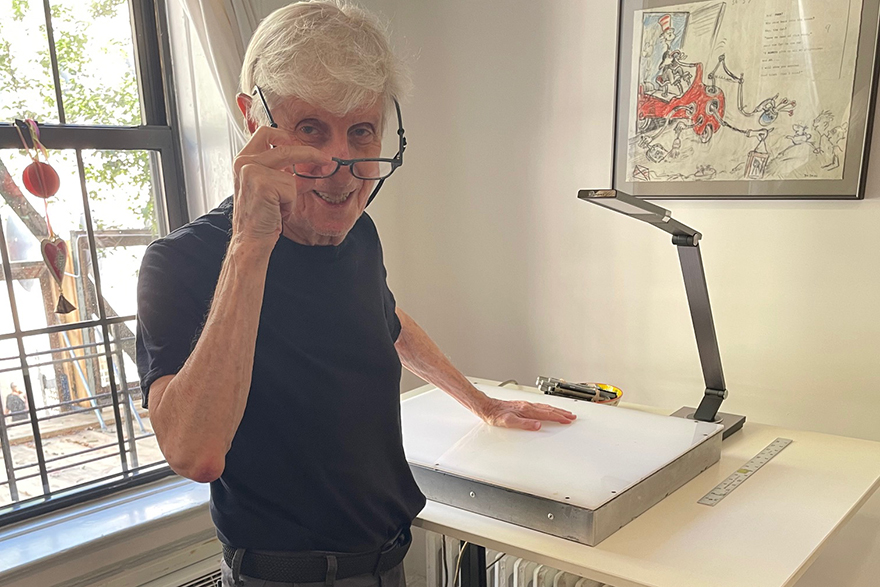
Stan Mack is best known for his nonfiction comic strip Stan Macks Real Life Funnies, a witty chronicle of New York life in the 70, 80, 90s, which ran in The Village Voice for over 20 years.A collection was published in 2024 and nominated for an Eisner Award.A graduate of the Rhode Island School of Design, Mack is also the author of several graphic nonfiction books on serious subjects.Now in his 80s, hes enjoyed a varied career, including as an art director and illustrator.
Senior Planet spoke to the legendary cartoonist in his home studio in Manhattan, where he lives with his wife, Susan Champlin, whom he met when she edited a comic strip he did for Modern Maturity magazine.SP: How did you get started in the art world?SM: After finishing art school in 1963, I moved to New York, and fell into an art director job at the New York Herald Tribune, the place where the New Journalism started.Think Tom Wolfe and Gloria Steinem.When that paper folded, I went to The New York Times as art director of their Sunday magazine, where I began to experiment with illustration as a reporting tool.
After a few years, I quit The Times and went freelance.SP: Lets talk about Real Life Funnies at The Village Voice.How did that comic strip get started?SM: I knew Milton Glaser was redesigning The Village Voice and I proposed a one shot piece combining art and reporting on New York.He said, Great, but do it as a weekly comic strip, itll build circulation.
The Voice was the hip paper of the downtown scene and the strip became hot very quickly.The idea of overhearing public conversation and then publishing it is a gimmick, but I took accuracy very seriously.SP: Can you explain more about your approach to Real Life Funnies?SM: I over heard people, and sometimes engaged them in conversation, and drew them.But In my mind I was a reporter and felt, if I changed any phrase I heard, Id screw it up.
I went to places where I didnt belong like Platos Retreat or a conference of UFO believers.Back then comics were fiction, so this was different, innovative, a different use for the comic strip form.SP: Your cartooning is basically poking fun and humor is very subjective.How did you do this without getting in trouble?SM: I offered anonymity.
I did not use peoples names.People were not offended because Id disguise them.The Voice always had lawyers at closing time going over the issue.
But I have been thrown out of places, a stranger taking notes could be a danger.I was once mistaken for an IRS agent and got thrown out of a high-end antique fair.SP: You were also a cartoonist for Modern Maturity magazine for many years.What were some of your topics? Whats it like to do humor for seniors?SM: This was in the 90s and Milton Glaser was redesigning Modern Maturity magazine.
He asked me to do a Real Life Funnies for people over 50.The strips were mainly based upon conversations, but people knew I was telling the truth.I did a cartoon about an aging biker trying to get into a retirement home when his girl friend was not 65.
I did a cartoon about an older woman who loved to dance but her boy friend had two left feet.When he did great on the dance floor, he told her that he channeled Fred Astaire.For the over 50 people, I thought the humor should be charming.SP: You also have a graphic memoir about caretaking for your partner when she had breast cancer.
What inspired you to create Janet and Me: An Illustrated Story of Love and Loss ?SM: I was her caretaker the whole way through.When she died, I started the book as a way to grieve properly, but also to share what I learned with other caregivers.Its a tribute to her.
Neither pure narrative nor comic strip.Its a hybrid.SP: What is a typical workday like for you?SM: That depends on the assignment.When I did Real Life Funnies I had weekly deadlines, so no screwing around.
I dont do newspaper or magazine assignments anymore.Im working on books so my day now is different.My last book took three years, one third research, one third writing, one third illustration.SP: What advice would you give to other creative people?SM: You should have a good time and be challenged.
Money might be animpetus but it is about the enjoyment of doing the work.SP: What was the most fun period of your career?SM: When I left The New York Times in 1973, I quit the 9-5 work world.It hasbeen fun ever since.SP: What does aging with attitude mean to you?SM: Im living it today.There is a spectrum of issues we all face in aging.
Try to cope with limitations, challenge yourself, and keep the enjoyment going.Next week my wife and I are going to LA to celebrate her mothers 100th birthday and were stopping in Montana to visit my forest ranger cousin.Kate Walter is the author of two memoirs:Behind the Mask: Living Alone in the Epicenter;andLookingfor a Kiss: A Chronicle of Downtown Heartbreak and Healing.Her essays and opinion pieces have appeared inThe New York Times, Newsday,New York Daily News, AM-NY, Next Avenue, The Advocate,The Village Sun and other outlets.She taught writing at CUNY and NYU for three decades and now works as a writing coach.Photo of Kate Walter by Su ZenPhoto of Stan Mack: Kate Walter
Publisher: Senior Planet ( Read More )

